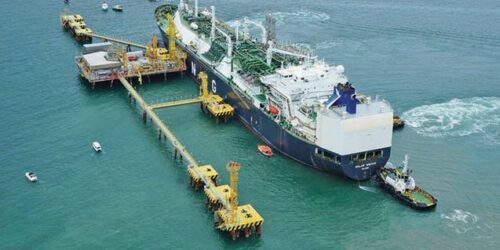The shale revolution has profoundly changed the market landscape for natural gas. The U.S. is now the largest nat gas producer in the world, due largely to technological development prompted by the shale renaissance. These advancements have substantially enhanced productivity and have cut costs per well.
Cheniere’s Sabine Pass and Corpus Christi: As the first mover in the U.S., Cheniere’s Sabine Pass (SPL) terminal in Cameron Parish, La., started exporting LNG in February 2016 while Corpus Christi LNG (CCL), which is situated in south Texas, began operations in 2018. Cheniere is one of the largest pipeline capacity holders in the U.S. As of April 30, 2021, SPL and CCL had contracted approximately 6,000[1] trillion British Thermal Units (TBtu) of natural gas feedstock through long-term and short-term natural gas supply contracts.
Cheniere is considered to be the world’s second-largest LNG operator as its export volume reached more than 105 million metric tons, equivalent to 1,525 cargoes, from both terminals as of April 2021.
Cameron LNG: Cameron LNG has obtained approval to export up to 14.95 million metric tons per annum (Mtpa) or approximately 2.1 billion cubic feet (Bcf) per day.
Freeport LNG: The terminal has a capacity of 1.98 Bcf per day baseload (2.14 Bcf/d peak capacity).
Several other brownfield and greenfield LNG projects are under construction and are expected to come online in the next few years. Most of these anticipated developments are located in the Gulf of Mexico, which offers a concentration of infrastructure capabilities and robust production. Additionally, the recent expansion of the Panama Canal provides an opportunity for U.S. Gulf Coast LNG to be economically shipped to the Pacific Basin.
Rising Influence Of Henry Hub
One of the most important implications of the U.S. LNG export projects is the rising influence of the U.S. Henry Hub price on global gas prices. Historically, the oil-indexation pricing mechanism was a cornerstone of LNG long-term contracts, especially in Asia. LNG was linked to oil prices with a three or four-month lag.
However, this mechanism has failed to accurately reflect the fundamentals of the gas market and limits the possibility of arbitrage. Due to these shortcomings, European Union energy policies and major suppliers have started to substitute oil index contracts with hub-based ones. Since 2015, Asian buyers have also sought to diversify the pricing structures of their LNG agreements, shifting away from long-term oil-linked contracts with traditional fixed-destination clauses.
Cheniere was the first U.S. supplier to introduce a Henry Hub-linked LNG formula. This formula is based on off-takers that are contracted to lift LNG and pay an approximate fixed fee between $2.25 to $3.50 per million British Thermal Unit (Mmbtu) plus a charge of 115% of the Henry Hub price. The fixed “take-or-pay” fee is paid irrespective of lifted volume and can be considered as a sunk cost.
The Henry Hub price and 15% charge represent the cost of procuring feedstock gas that is variable depending on the volume lifted. Shipping and re-gasification costs are covered by the downstream participant or off-taker. An important implication of this structure is that the trading determination process is driven by the spread or margin between Henry Hub versus regional spot LNG prices and the variable costs (shipping, regas) while ignoring the fixed fee which is considered as a sunk cost.
The critical element to the new LNG global trade is the structural advantage that now exists in the United States: ample natural gas supply, robust infrastructure, a sound financial system, and a well-developed commodity trading apparatus. The U.S. is a major LNG exporter, which makes Henry Hub an even more important price reference in global gas trading.






